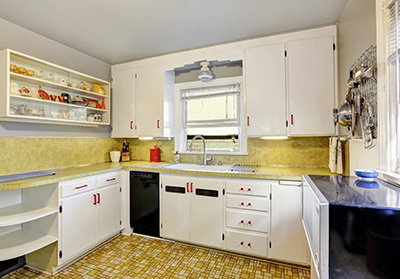Asbestos in Linoleum & Vinyl Flooring: A Complete Guide
First patented in 1860, linoleum is a versatile, affordable flooring option that came in many patterns and colors. Along with vinyl sheet flooring, a similar product, it was used in homes throughout much of the 20th century. But these popular flooring materials may contain hazardous asbestos. When cut, damaged or otherwise disturbed, asbestos linoleum and vinyl release tiny fibers into the air that can cause cancers like mesothelioma if inhaled.
Does Linoleum Have Asbestos?
Yes, some linoleum produced before 1980 may contain asbestos.
Asbestos was often added to both linoleum and vinyl products, however, there are a few differences between these types of flooring. Linoleum was most popular from the 1920s through the 1950s. It’s made of a combination of dried linseed oil, cork, wood dust and jute, a coarse fiber.
Vinyl is a synthetic material that’s made by heating and drying polyvinyl chloride (PVC). It became popular in the 1960s as a cheaper alternative to linoleum. Asbestos in vinyl flooring is more common than linoleum. However, both methods of production could have involved adding asbestos.
What Does Asbestos in Flooring Look Like?

It’s hard to tell whether there is asbestos in linoleum or vinyl flooring just by looking at it. One thing you can look for is a black adhesive, known as mastic, that was used to install linoleum and vinyl and nearly always contains asbestos. Other things to consider include:
- Installation date: It’s safest to assume that there is asbestos in linoleum or vinyl flooring that was installed before the mid-1980s. While construction materials weren’t made with asbestos after 1980, suppliers continued to sell asbestos products they already had in stock.
- Location: Asbestos was added to linoleum, vinyl and floor tiles to increase durability and heat resistance. It was often installed in high-heat areas, like the kitchen, and high-traffic areas, like entryways and hallways.
- Multiple flooring layers: If a previous homeowner knew the home contained linoleum with asbestos, they may have covered it up or sealed it with another material, resulting in a floor made up of multiple layers.
The only way to be sure if your linoleum has asbestos is to test a sample. You can get an at-home testing kit, but calling a professional to perform testing is the safest option.
Known Manufacturers of Asbestos Linoleum
Another thing you can look for is the manufacturer of your linoleum or vinyl flooring. While it can be hard to find, if you have access to building records or receipts, you may be able to determine if the manufacturer was one of many asbestos companies that used it in flooring products:
- American Biltrite
- Amtico Flooring
- Armstrong
- Congoleum
- EverWear
- Fashionflor
- Flintkote
- GAF Corporation
- Gold Seal
- Goodyear
- Kentile
- Montgomery Ward
- National Gypsum
- Sears-Roebuck
- Solarian
- Synkoloid
Health Risks Associated with Asbestos Linoleum and Vinyl
Asbestos linoleum and vinyl become a health hazard when they’re disturbed or damaged, releasing fibers into the air. Asbestos fibers are invisible to the human eye, but extremely damaging to the lungs. When inhaled, they become lodged in the lung tissue, causing inflammation and scarring. It can take decades for asbestos-related diseases to appear, but eventually exposure can lead to diseases like mesothelioma, lung cancer and asbestosis.
Certain at-risk occupations who are exposed to asbestos linoleum or vinyl over a long period of time may have a higher likelihood of developing health problems. These occupations include:
- Carpenters
- Construction contractors
- Demolition contractors
- Flooring installers
- Handymen
- Linoleum factory workers
- Maintenance workers
- Vinyl factory workers
Removing Asbestos Linoleum & Vinyl
Because linoleum and vinyl only release asbestos fibers when they’re disturbed, it’s usually best to avoid removing this type of flooring. Instead of removing it, you can seal it and cover it with a new type of flooring. Both linoleum and vinyl are thin, smooth surfaces, so they’re easy to cover with hardwood, ceramic tiles or laminate.
If you still want to remove linoleum with asbestos, first you’ll need to check your local and state regulations. Many areas regulate asbestos projects and may require certain notifications or disposal methods. As the homeowner, you’ll take on the legal liability of ensuring correct bagging, transport and disposal of asbestos waste.
You’ll also need to follow certain regulations to remove the linoleum and vinyl while minimizing asbestos exposure—both for yourself and your family and community. You’ll need to:
- Seal off the room with plastic sheeting and close any HVAC ducts
- Wear a protective suit, gloves and goggles and use a respirator
- Use safe asbestos removal practices like wetting down surfaces
- Wipe down all surfaces and clean up dust using vacuums with special filters
- Have a professional test the air to ensure all asbestos is gone
Most homeowners don’t have the specialized materials and equipment they need to safely remove asbestos linoleum, which can make it an expensive project. It’s usually best to call a professional contractor who specializes in asbestos removal.
Legal Actions Following Exposure to Asbestos Linoleum
Exposure to asbestos in vinyl flooring is more common than linoleum and has resulted in several mesothelioma lawsuits. Several companies have also created asbestos trust funds because of their flooring products. For example, Congoleum, once one of the largest linoleum manufacturers in the world, created a trust fund worth $270 million during its bankruptcy proceedings in 2010.
If you or a family member has been diagnosed with mesothelioma due to exposure to asbestos linoleum or vinyl, you may be entitled to compensation for your medical bills, lost wages and pain and suffering.
An experienced mesothelioma law firm, like Early, Lucarelli, Sweeney and Meisenkothen, can fight for you in court. Contact our team today for a free case evaluation.
Frequently Asked Questions
What are the dangers of asbestos in linoleum flooring?
Linoleum and vinyl flooring made with asbestos releases microscopic fibers into the air when it’s disturbed or damaged. Exposure primarily occurred during the installation of these materials. Today, it more commonly happens during renovations, because sanding, drilling, cutting and ripping up asbestos linoleum and vinyl can all release these fibers. When inhaled, the fibers become permanently embedded in the lungs and can cause dangerous diseases decades later, including mesothelioma, lung cancer and asbestosis.
How can I identify and remove asbestos in linoleum flooring?
It’s hard to tell from appearance alone whether your linoleum contains asbestos. If your flooring was installed before the mid-1980s, it’s safest to test it for asbestos before doing any renovations. If it does contain asbestos, you should call a professional asbestos removal contractor. They’ll have the equipment and expertise needed to remove it safely.
Which vinyl products may contain asbestos?
Vinyl building materials made before 1980 may contain asbestos. This includes vinyl floor tiles, sheet flooring and wallpaper. It’s an affordable, easily obtained material and is still popular in homes today. While American companies no longer make vinyl products with asbestos, it could still be imported from other countries.
Request a Free Case Evaluation
Request a free case evaluation now if you or someone you love has been diagnosed with mesothelioma. The evaluation will cost you nothing. Our lawyers will travel to visit you at your convenience or conference call with you over the phone. We understand how difficult a time this is for you and will assist in any way that we can. You can also call us toll-free at 1-800-336-0086 at any time.

Results
The jury awards and settlements we have received for our clients are among the highest in the country.
Occupation/Exposure
Mechanic
Age
66
State
WA
Results
~$102,200,000
Occupation/Exposure
Cosmetic Talc User
Age
75
State
AZ
Results
~$22,200,000
Occupation/Exposure
Talc Powder User
Age
59
State
UT
Results
~$20,000,000
Occupation/Exposure
Home Renovator
Age
75
State
RI
Results
~$15,100,000
Occupation/Exposure
Electrician
Age
62
State
NV
Results
~$13,800,000
Occupation/Exposure
Plumber
Age
49
State
CA
Results
~$13,500,000
Occupation/Exposure
Abatement Worker
Age
70
State
CT
Results
~$12,600,000
Occupation/Exposure
Pipefitter
Age
58
State
OH
Results
~$12,200,000
Occupation/Exposure
Pipefitter
Age
65
State
NV
Results
~$12,000,000
Occupation/Exposure
Navy Veteran
Age
48
State
CA
Results
~$11,700,000
Occupation/Exposure
Air Force Veteran
Age
84
State
KY
Results
~$11,700,000
Occupation/Exposure
Hairdresser
Age
66
State
MD
Results
~$11,500,000
